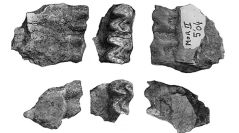

 Comptes Rendus Palevol
3 (8) - Pages 675-690
Comptes Rendus Palevol
3 (8) - Pages 675-690Three genera of hyracoids were recorded from the Early Miocene of East Africa by Whitworth, but there has been considerable divergence of opinion about their status. Despite differences in cranial and dental morphology from Megalohyrax and Bunohyrax, Whitworth classified two species in these genera that are recorded from much earlier deposits (Early Oligocene) in the Fayum, Egypt. One of his genera (Meroehyrax) was new. His classification has been the subject of debate, with some researchers doubting the hyracoid status of one of his species ( unohyrax sp), and changing the generic status of another (Megalohyrax championi). Meyer recorded a fourth genus (Prohyrax) from Kenya, linking it to material from Namibia described by Stromer. New samples of two hyracoid species collected by the Uganda Palaeontology Expedition throw light on their systematic position and taxonomy. It is concluded that there are three hyracoid genera (Afrohyrax, Brachyhyrax and Meroehyrax) in the Early Miocene deposits of East Africa, the first two of which are new. A fourth genus (Prohyrax) occurs in southern Africa, but is not reliably known from East Africa.
Hyracoidea, East Africa, Early Miocene, Taxonomy, Systematics